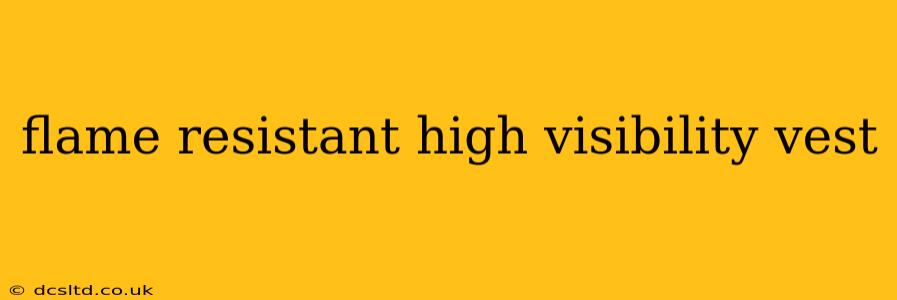Staying safe in hazardous environments requires the right protective gear. For workers in industries like construction, manufacturing, and oil and gas, a flame resistant high visibility vest is paramount. This isn't just about compliance—it's about saving lives. This comprehensive guide will delve into the crucial aspects of these vests, helping you understand their importance and how to choose the right one.
What is a Flame Resistant High Visibility Vest?
A flame resistant high visibility vest combines two critical safety features: flame resistance and high visibility. Flame resistant materials are designed to self-extinguish or slow the spread of flames, minimizing the risk of severe burns. High visibility features, typically bright colors like orange, yellow, or lime green, and reflective strips, ensure the wearer is easily seen in low-light conditions or hazardous environments, reducing the risk of accidents involving vehicles or machinery.
The combination makes these vests essential for individuals working near open flames, sparks, or in environments with potential fire hazards while also needing to be highly visible to others.
Why is a Flame Resistant High Visibility Vest Important?
The importance of this type of vest cannot be overstated. It provides a dual layer of protection:
-
Protection from Fire: The flame-resistant fabric significantly reduces the risk of serious burns in the event of a flash fire or contact with flames. This protection can be the difference between minor injuries and life-threatening burns.
-
Increased Visibility: High visibility features, such as bright colors and reflective tape, make the wearer easily noticeable, especially in low-light conditions, reducing the risk of accidents caused by being overlooked by vehicles or other equipment.
What Standards Should a Flame Resistant High Visibility Vest Meet?
Choosing a vest that meets relevant safety standards is crucial. Look for vests that meet or exceed the following standards:
-
NFPA 70E: This standard covers electrical safety in the workplace and often dictates the requirements for arc flash protection, which might overlap with flame resistance needs.
-
NFPA 2112: This standard sets the requirements for flame-resistant clothing. Check for certification confirming the vest meets this standard.
-
ANSI/ISEA 107: This standard outlines the requirements for high-visibility safety apparel. Look for Class 2 or Class 3 certification, with Class 3 offering the highest level of visibility.
Always check the specific certifications and ratings on the vest to ensure it meets the requirements for your specific work environment.
What Materials are Used in Flame Resistant High Visibility Vests?
Several materials are commonly used in the construction of these vests, each offering varying levels of flame resistance and durability:
-
Nomex: A well-known and widely used material known for its excellent flame resistance and durability.
-
Kevlar: Another high-performance fiber offering exceptional strength and heat resistance.
-
Modacrylic: A synthetic fiber that provides good flame resistance and is often blended with other fabrics for improved comfort and durability.
The specific material will influence the vest's overall performance, comfort, and price.
How to Choose the Right Flame Resistant High Visibility Vest?
Selecting the appropriate vest requires careful consideration of several factors:
-
Work Environment: Assess the specific hazards present in your workplace to determine the necessary level of flame resistance and visibility.
-
Fit and Comfort: A well-fitting vest is crucial for both safety and comfort. Ensure it allows for full range of motion without being too tight or loose.
-
Durability: Opt for a vest constructed from durable, high-quality materials that can withstand regular wear and tear.
-
Additional Features: Consider features like pockets, reflective tape placement, and any required certifications specific to your industry.
Where Can I Find Flame Resistant High Visibility Vests?
Many safety equipment suppliers and online retailers offer a wide variety of flame resistant high visibility vests. It's important to purchase from reputable sources to ensure you're getting a genuine, certified product. Always check reviews and ensure the supplier can provide proof of certifications.
How Do I Care for My Flame Resistant High Visibility Vest?
Following the manufacturer's care instructions is crucial to maintain the vest's flame resistance and durability. Generally, this includes gentle washing, avoiding harsh chemicals, and allowing the vest to air dry. Improper care can compromise the effectiveness of the protective features.
Are Flame Resistant High Visibility Vests Washable?
Yes, most flame-resistant high visibility vests are washable. However, it’s essential to always check the manufacturer's care instructions. Using the incorrect washing method or detergents can damage the fabric and compromise its flame-resistant properties. Often, gentle machine washing in cold water and air drying is recommended.
What is the Difference Between Class 2 and Class 3 High Visibility Vests?
The difference lies in the amount of reflective material and the overall visibility provided. Class 3 vests offer significantly more reflective material and brighter colors, providing superior visibility in low-light conditions compared to Class 2 vests. The choice depends on the specific needs of the work environment.
This comprehensive guide provides a foundation for understanding the critical role of flame resistant high visibility vests in workplace safety. By carefully considering the factors discussed, you can select the appropriate vest to ensure your safety and compliance with relevant regulations. Remember, safety is paramount, and investing in high-quality protective gear is an investment in your well-being.
